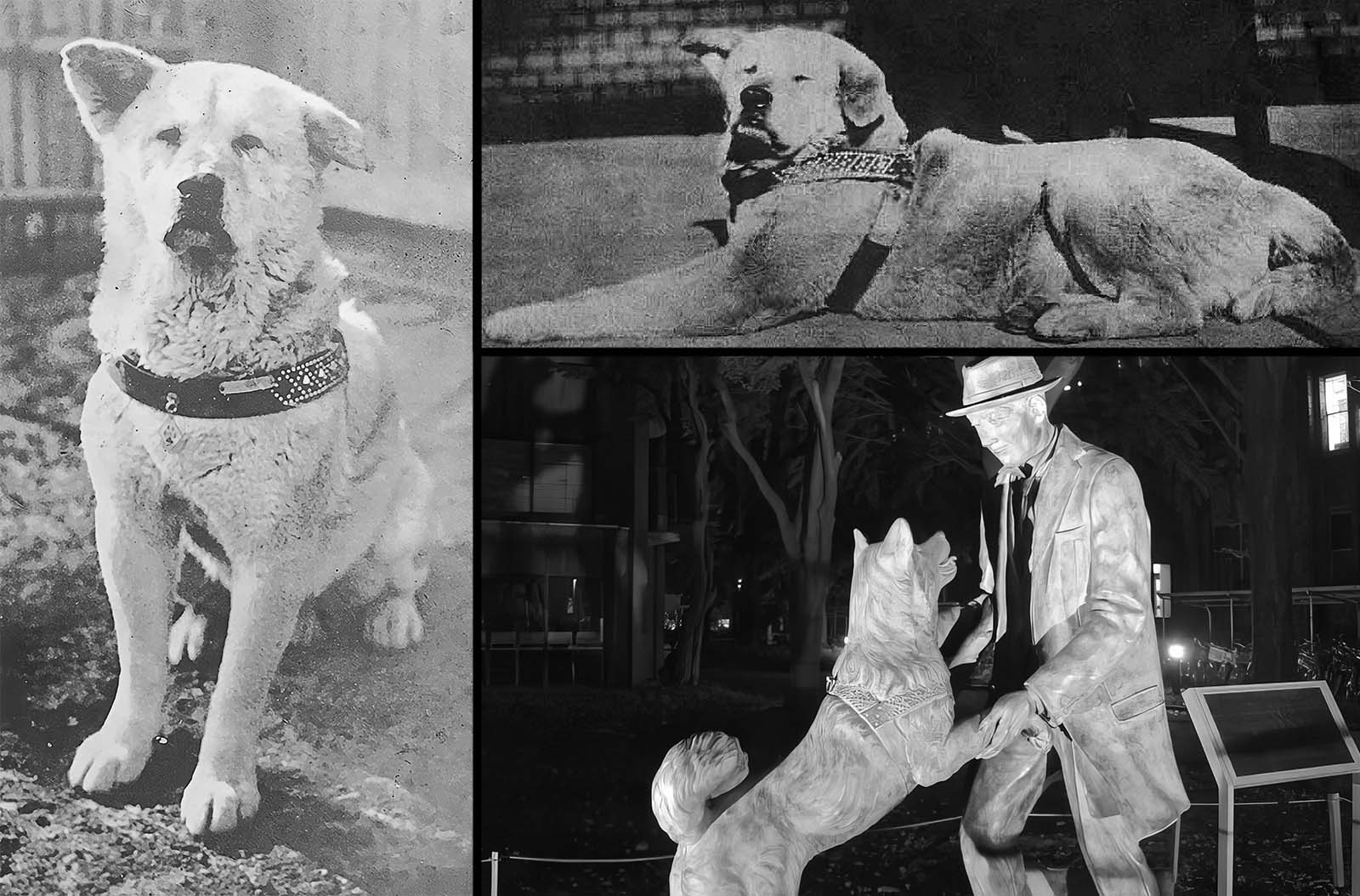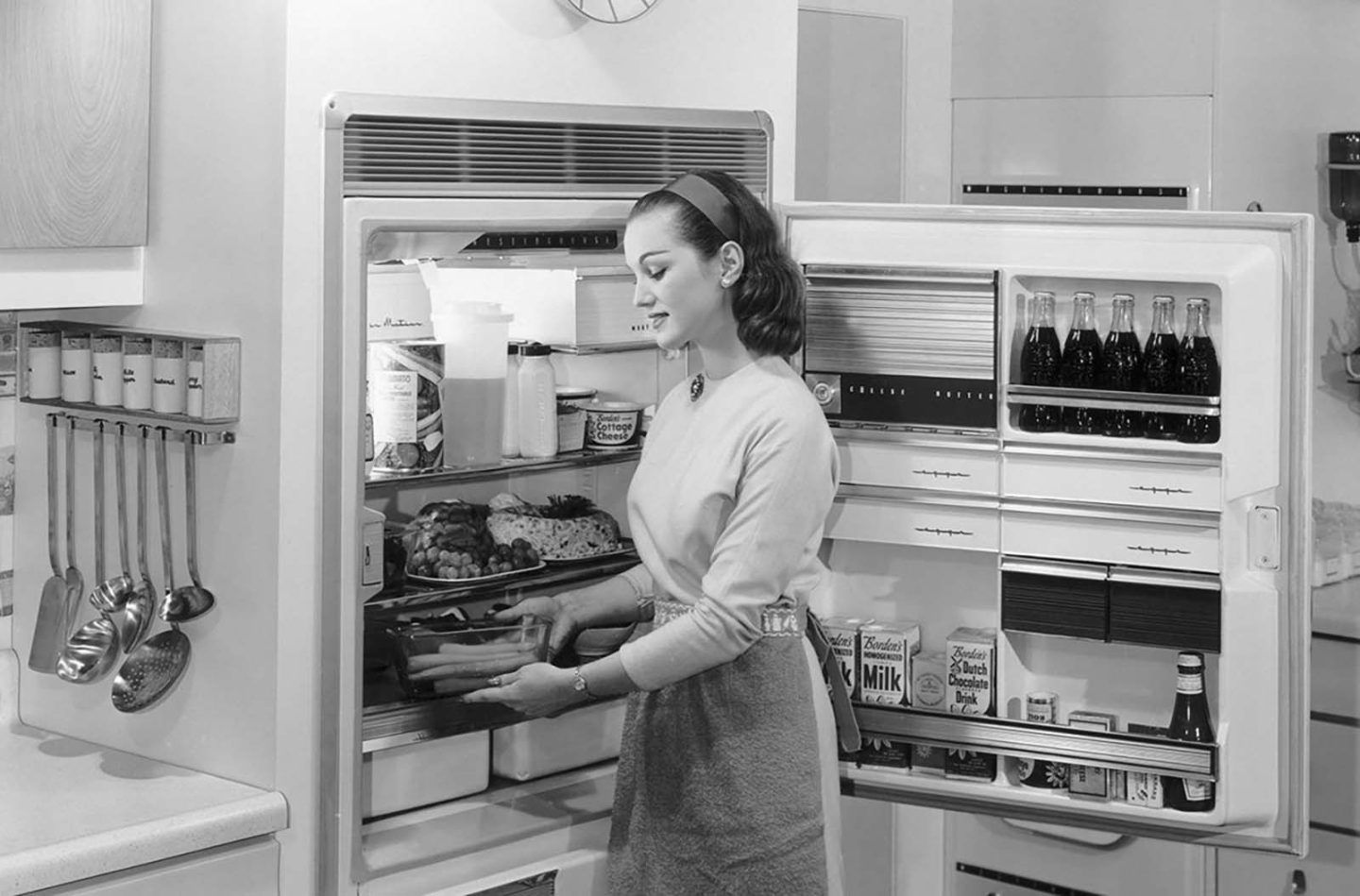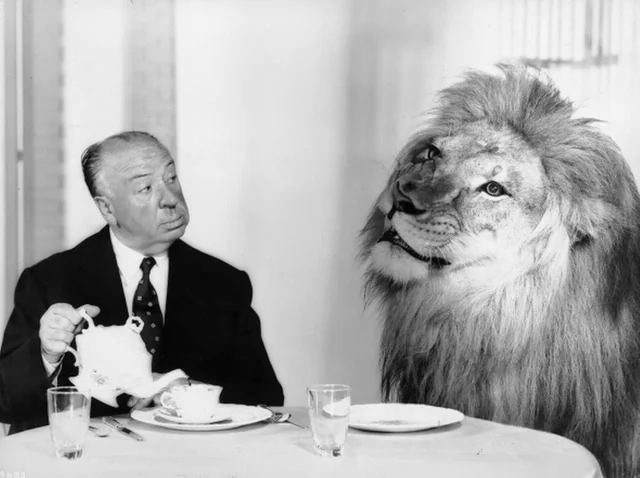Every day between 1925 and 1935, Hachiko, a dog with unwavering loyalty, turned Tokyo’s Shibuya train station into the stage for his daily vigil, hoping against hope for the return of his deceased owner.
Hachiko wasn’t just a pet; he was the faithful companion of a university professor, dutifully awaiting his master’s return from work at the local train station each evening.
Tragedy struck when the professor passed away suddenly, leaving Hachiko to continue his vigil at the station for nearly a decade.
Undeterred by the occasional disapproval of the station employees, Hachiko persisted in his daily routine.
Over time, Hachiko’s unwavering dedication touched the hearts of the station staff, transforming him into an international sensation and an emblem of loyalty.
This is the true story of Hachiko, the dog whose devotion made him history’s most loyal dog.

How Hachiko and his owner Hidesaburō Ueno met?
Hachiko, a white Akita, came into the world on November 10, 1923, at a farm in Ōdate, Akita Prefecture, Japan.
Meanwhile, Ueno Hidesaburō, a professor in the Department of Agriculture at Tokyo Imperial University (now the University of Tokyo), was on the lookout for a purebred Japanese dog. A thoughtful student working in Akita secured the dog from Saitō for Ueno.
Akita-inu dogs, renowned for their large size, gentle nature, and thick, fluffy coats, have gained a global following for their unwavering loyalty.
Originating in the 1630s through the cross-breeding of Matagi hunting dogs and local breeds, they were developed for their prowess in combat.

Hachiko with an unknown family.
In January 1924, a 50-day-old puppy set out on a 20-hour train adventure to Ueno Station in Tokyo, cozily bundled in a rice bag to ward off the winter cold.
Shortly after, he was sent to the home of Ueno Hidesaburō, near Shibuya Station.
Despite being childless, the professor showered affection on the pup, letting him snuggle under his bed and joining him for meals.
The name Hachi was chosen for the dog because, when he stood, his front legs formed the shape of the character 八, which means “eight” and is pronounced hachi.

Hachikō at Shibuya station, c. 1933.
Sudden Separation
Every day, Ueno made his daily journey to work, following a familiar routine with Hachiko. In the mornings, the pair would walk to Shibuya Station, where Ueno caught the train to his workplace.
After finishing his classes for the day, Ueno would return on the train, punctually reaching the station at 3 p.m. There, Hachiko patiently awaited his companion, ready to accompany him on the journey home.
This routine continued until May 21, 1925, when Ueno failed to return.
The professor had suffered a cerebral hemorrhage while he was giving a lecture to his class, and he died without ever returning to the train station at which Hachiko waited.

Hachiko in 1934.
Despite this disruption in his routine, Hachiko returned the next day at the same time, hoping that Ueno would be there to meet him.
But, of course, the professor didn’t come home. Still, Hachiko, the faithful Akita, never gave up hope.
Even after Hachiko was given away following his master’s passing, he continued to sneak off to Shibuya Station at 3 PM, hoping to meet the professor.
Every single day, for the next 9 years, 9 months, and 15 days, Hachiko made his way to the station, morning and evening, where he would wait outside the ticket gates, rain, snow, or shine.
It seemed he was forever hoping that his master would eventually return. Soon, the lone dog began to draw the attention of other commuters.
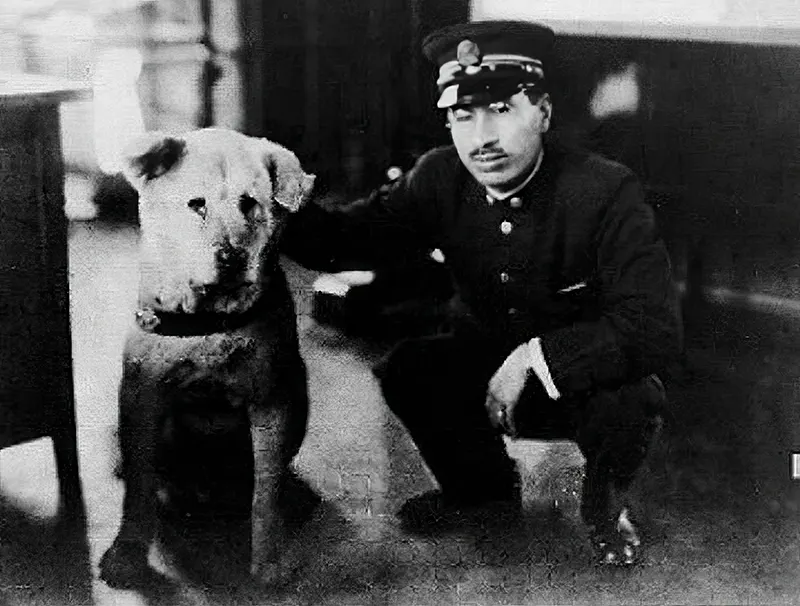
Hachiko sits with a train conductor at Shibuya Station.
The Story of Hachiko Became a National Sensation
In the beginning, the station workers weren’t all that friendly to Hachiko, but his loyalty won them over.
Before long, they started bringing treats for the devoted dog and even kept him company from time to time.
As the days turned into weeks, then months and years, Hachiko remained a daily presence at the station. His impact reached far beyond, turning him into an icon in the Shibuya community.
Eventually, Hirokichi Saito, a former student of Professor Ueno and an expert on the Akita breed, got wind of Hachiko’s story.

Saito, who had become an expert on the Akita breed, spotted the dog at the station and followed him to the home of Ueno’s former gardener, Kozaburo Kobayashi. It was there that he unraveled the history of Hachiko’s life.
Shortly after the meeting, Saito conducted a thorough census of Akitas in Japan. His findings revealed only 30 remaining purebred Akitas, among them Hachiko from Shibuya Station.
He returned frequently to visit Hachiko, and over the years he published several articles about the dog’s remarkable loyalty.
In 1932, one of his articles, published in Asahi Shimbun, placed the dog in the national spotlight.
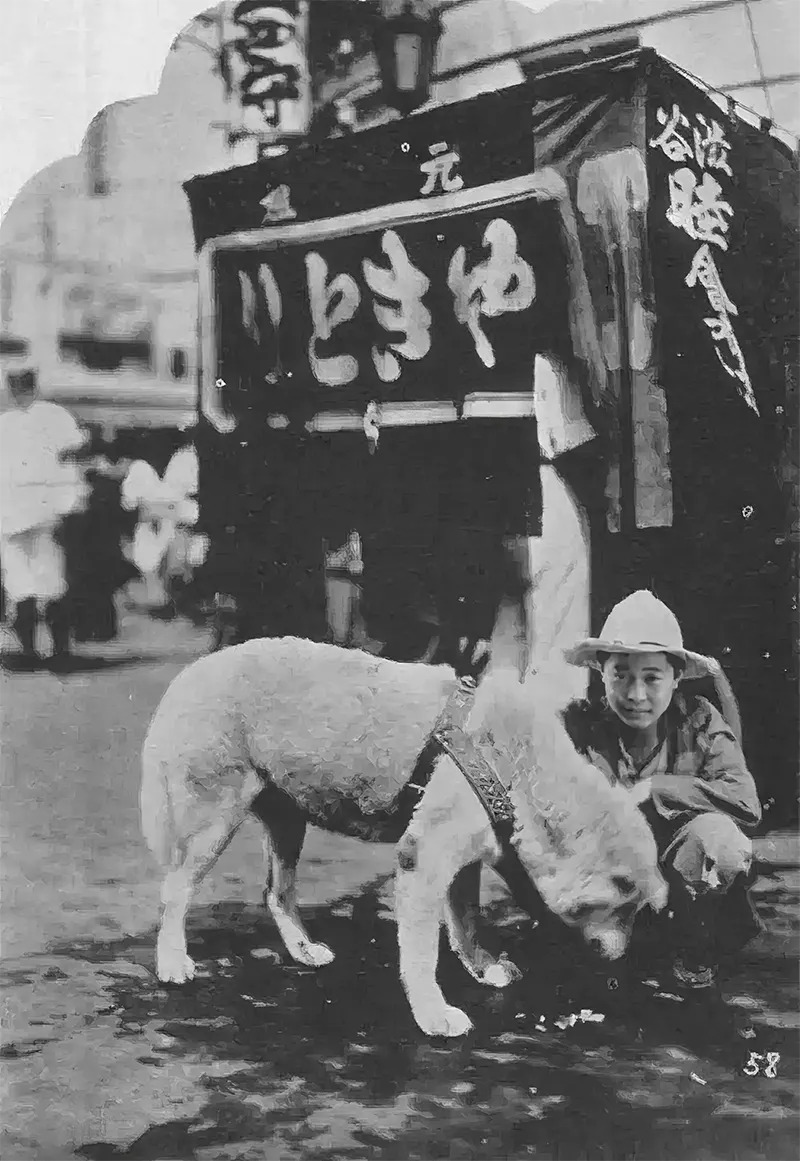
Visitors came from far and wide to meet Hachiko.
His faithfulness to his master’s memory impressed the people of Japan as a spirit of family loyalty to which all should strive to achieve. Teachers and parents used Hachiko’s vigil as an example for children to follow.
Hachiko’s story finally came to an end on March 8, 1935, when he was found dead in the streets of Shibuya at the age of 11.
In March 2011, scientists finally settled the cause of death of Hachiko: the dog had both terminal cancer and a filaria infection.

The last known photo of Hachiko – pictured with his owner’s partner Yaeko Ueno (front row, second from right) and station staff in mourning in Tokyo on March 8, 1935.
The Legacy of Hachiko
After his death, Hachiko’s remains were cremated and his ashes were buried in Aoyama Cemetery, Minato, Tokyo where they rest beside those of Hachiko’s beloved master, Professor Ueno.
Many people, young and old, came to pay their respects, including Yae and Shibuya Station staff.
Hachiko’s pelt was preserved after his death, and his taxidermy mount is on permanent display at the National Science Museum of Japan in Ueno, Tokyo.

Hachiko and train passengers.
In April 1934, a bronze statue based on his likeness sculpted by Teru Ando was erected at Shibuya Station.
The statue was recycled for the war effort during World War II. In 1948, Takeshi Ando (son of the original artist) made a second statue.
The new statue, which was erected in August 1948, still stands and is a popular meeting spot.
The station entrance near this statue is named “Hachikō-guchi”, meaning “The Hachiko Entrance/Exit”, and is one of Shibuya Station’s five exits.

People brought Hachiko food and fed the loyal dog.
On March 9, 2015, the Faculty of Agriculture of the University of Tokyo unveiled a bronze statue depicting Ueno returning to meet Hachiko at the University of Tokyo, Japan to commemorate the 80th anniversary of Hachiko’s death.
Each year on March 8, Hachiko’s devotion is honored with a solemn ceremony of remembrance at Shibuya Station. Hundreds of dog lovers often turn out to honor his memory and loyalty.
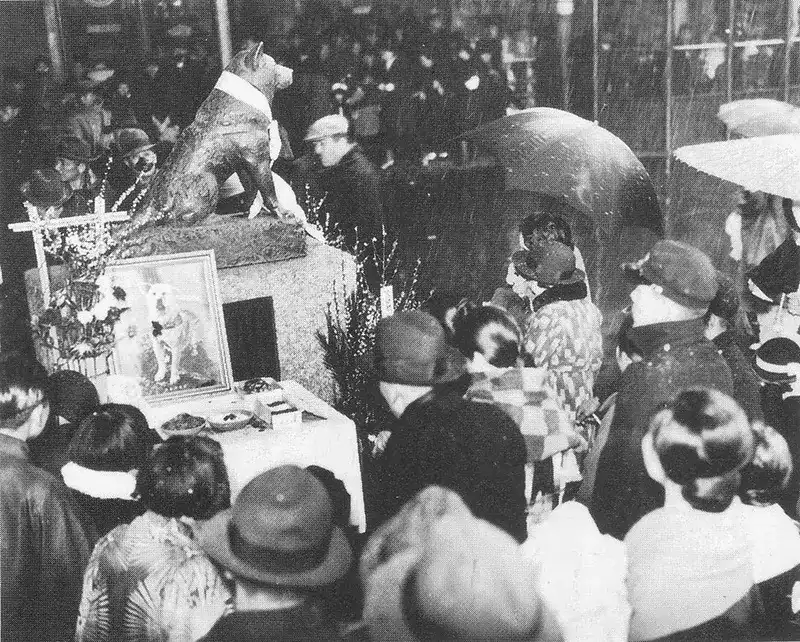
March 8, 1936, the first anniversary of Hachiko’s death.
Yaeko Sakano: Ueno’s Wife
Yaeko Sakano, often known as Yaeko Ueno, was the partner of Hidesaburō Ueno for about 10 years until he passed away in 1925. Whenever she visited, Hachiko showed a lot of happiness and affection towards her.
Sadly, Yaeko passed away on April 30, 1961, at the age of 76. She wanted to be buried next to Ueno, but her family laid her to rest in a temple in Taitō instead.

This stuffed replica of Hachikō is currently on display at the National Science Museum of Japan in Ueno, Tokyo.
In 2013, a professor at the University of Tokyo named Sho Shiozawa found records showing Yaeko’s wish to be buried with Ueno.
Then, on May 19, 2016, a special ceremony took place at Aoyama Cemetery. Both the Ueno and Sakano families were there.
During the ceremony, some of Yaeko Sakano’s ashes were buried alongside Ueno and Hachiko. Her name and the date of her passing were written on their tombstone. This fulfilled the reunion of Hachiko’s family.
“Putting both their names on the grave helps future generations understand that Hachiko had two special people in his life,” said Shiozawa. “To Hachiko, Ueno was like a father, and Yaeko was like a mother,” added Matsui.
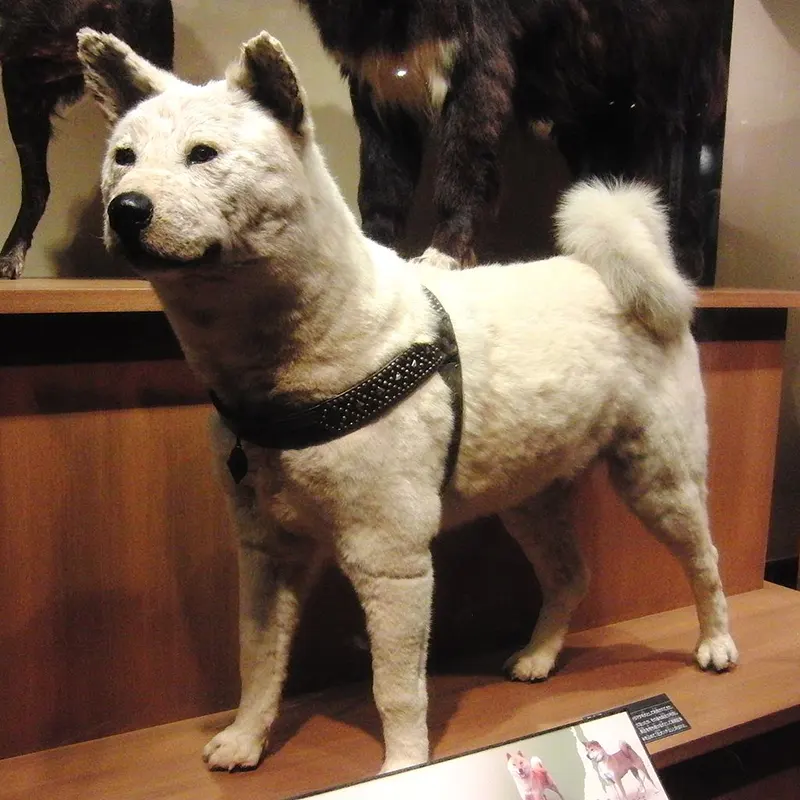
Hachikō’s taxidermied fur exhibited at the National Museum of Nature and Science in Ueno.
Hachiko’s Story in Pop Culture
The story of Hachiko touched hearts across the globe long before the war. Even Helen Keller, the American educator and champion of disability rights, visited his statue in 1937.
She was so taken by Hachiko’s tale that she wished for her own Akita-inu. In 1937, she was gifted one, and after it passed away in 1939, she received another.

The statue in 2013.
In 2009, Richard Gere starred in the American movie “Hachi: A Dog’s Tale,” a remake of the 1987 Japanese film “The Story of Hachiko” by Shindō Kaneto.
Gere, who also produced the American version, admitted that reading the script brought tears to his eyes.
According to Saitō Hirokichi, who dedicated his life to preserving Japanese dog breeds, “When we think of Hachiko’s loyalty at Shibuya Station, it’s like a moving story of faithful service.
But, really, Hachiko’s love for his master was just pure affection. It’s not just Hachiko; all dogs have this kind of unconditional and absolute love.”

A statue depicting Hachikō greeting Professor Ueno, at the Faculty of Agriculture of the University of Tokyo.
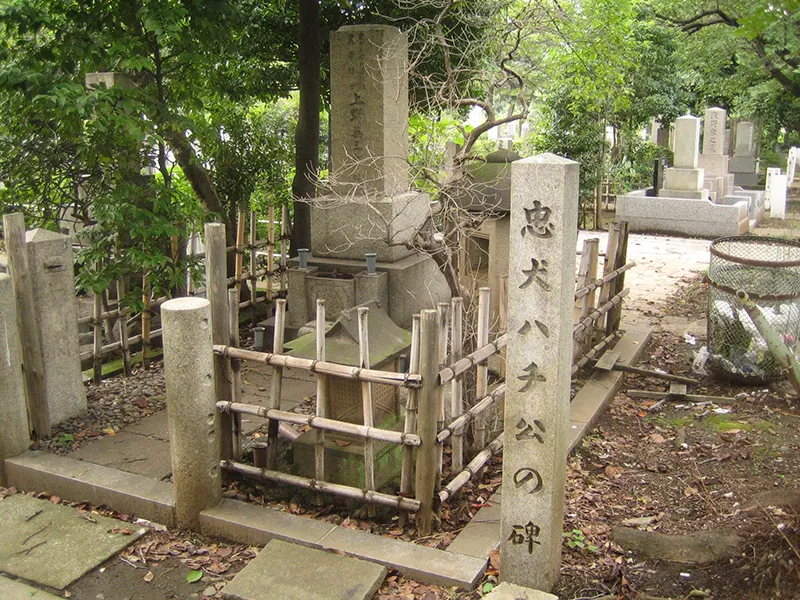
Hachikō’s grave beside Professor Ueno’s grave in Aoyama Cemetery, Minato, Tokyo.
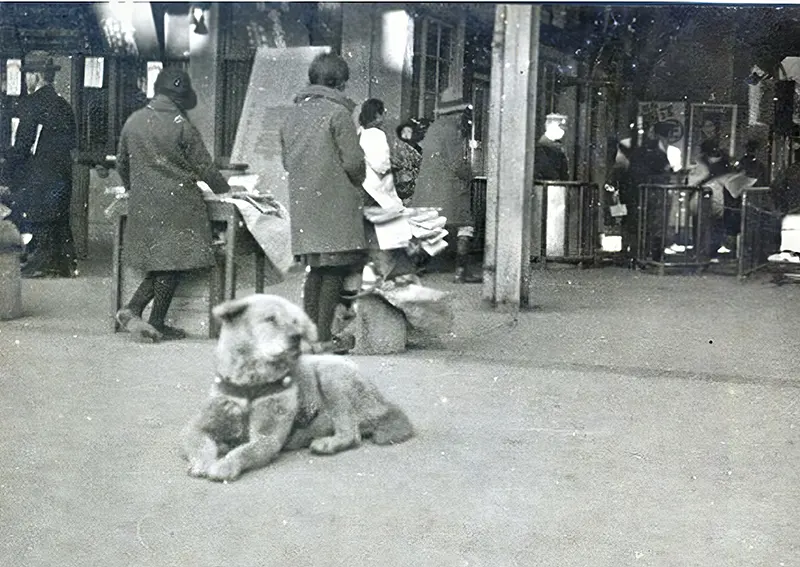
Hachiko at the train station.
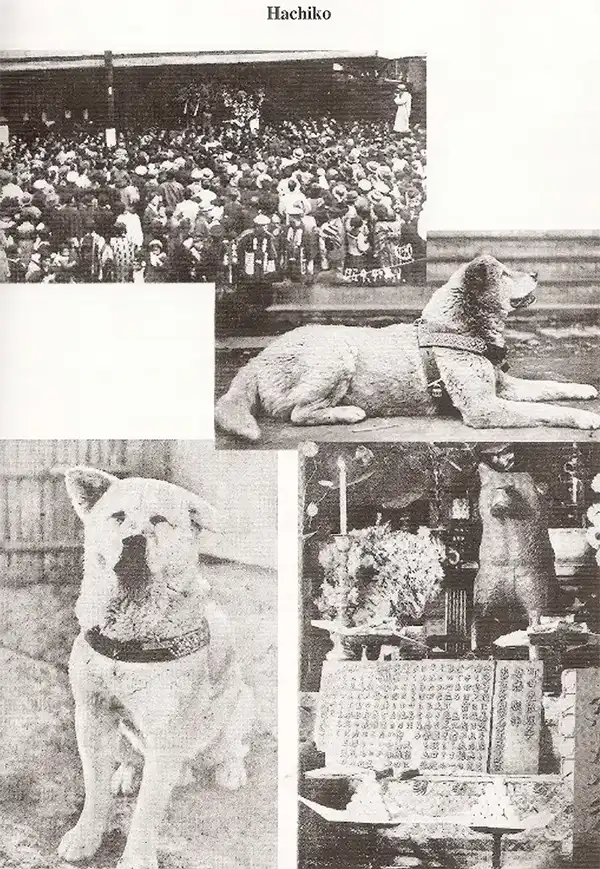
Hachiko’s photos in local newspapers.


(Photo credit: Wikimedia Commons / Pinterest / Flickr).
Hachiko: The True Story of a Loyal Dog Who Waited For His Deceased Owner for Ten Years
Hachiko wasn’t just a pet; he was the faithful companion of a university professor, dutifully awaiting his master’s return from work at the local train station each evening.
Tragedy struck when the professor passed away suddenly, leaving Hachiko to continue his vigil at the station for nearly a decade.
Undeterred by the occasional disapproval of the station employees, Hachiko persisted in his daily routine.
Over time, Hachiko’s unwavering dedication touched the hearts of the station staff, transforming him into an international sensation and an emblem of loyalty.
This is the true story of Hachiko, the dog whose devotion made him history’s most loyal dog.

How Hachiko and his owner Hidesaburō Ueno met?
Hachiko, a white Akita, came into the world on November 10, 1923, at a farm in Ōdate, Akita Prefecture, Japan.
Meanwhile, Ueno Hidesaburō, a professor in the Department of Agriculture at Tokyo Imperial University (now the University of Tokyo), was on the lookout for a purebred Japanese dog. A thoughtful student working in Akita secured the dog from Saitō for Ueno.
Akita-inu dogs, renowned for their large size, gentle nature, and thick, fluffy coats, have gained a global following for their unwavering loyalty.
Originating in the 1630s through the cross-breeding of Matagi hunting dogs and local breeds, they were developed for their prowess in combat.

Hachiko with an unknown family.
In January 1924, a 50-day-old puppy set out on a 20-hour train adventure to Ueno Station in Tokyo, cozily bundled in a rice bag to ward off the winter cold.
Shortly after, he was sent to the home of Ueno Hidesaburō, near Shibuya Station.
Despite being childless, the professor showered affection on the pup, letting him snuggle under his bed and joining him for meals.
The name Hachi was chosen for the dog because, when he stood, his front legs formed the shape of the character 八, which means “eight” and is pronounced hachi.

Hachikō at Shibuya station, c. 1933.
Sudden Separation
Every day, Ueno made his daily journey to work, following a familiar routine with Hachiko. In the mornings, the pair would walk to Shibuya Station, where Ueno caught the train to his workplace.
After finishing his classes for the day, Ueno would return on the train, punctually reaching the station at 3 p.m. There, Hachiko patiently awaited his companion, ready to accompany him on the journey home.
This routine continued until May 21, 1925, when Ueno failed to return.
The professor had suffered a cerebral hemorrhage while he was giving a lecture to his class, and he died without ever returning to the train station at which Hachiko waited.

Hachiko in 1934.
Despite this disruption in his routine, Hachiko returned the next day at the same time, hoping that Ueno would be there to meet him.
But, of course, the professor didn’t come home. Still, Hachiko, the faithful Akita, never gave up hope.
Even after Hachiko was given away following his master’s passing, he continued to sneak off to Shibuya Station at 3 PM, hoping to meet the professor.
Every single day, for the next 9 years, 9 months, and 15 days, Hachiko made his way to the station, morning and evening, where he would wait outside the ticket gates, rain, snow, or shine.
It seemed he was forever hoping that his master would eventually return. Soon, the lone dog began to draw the attention of other commuters.

Hachiko sits with a train conductor at Shibuya Station.
The Story of Hachiko Became a National Sensation
In the beginning, the station workers weren’t all that friendly to Hachiko, but his loyalty won them over.
Before long, they started bringing treats for the devoted dog and even kept him company from time to time.
As the days turned into weeks, then months and years, Hachiko remained a daily presence at the station. His impact reached far beyond, turning him into an icon in the Shibuya community.
Eventually, Hirokichi Saito, a former student of Professor Ueno and an expert on the Akita breed, got wind of Hachiko’s story.

Shortly after the meeting, Saito conducted a thorough census of Akitas in Japan. His findings revealed only 30 remaining purebred Akitas, among them Hachiko from Shibuya Station.
He returned frequently to visit Hachiko, and over the years he published several articles about the dog’s remarkable loyalty.
In 1932, one of his articles, published in Asahi Shimbun, placed the dog in the national spotlight.

Visitors came from far and wide to meet Hachiko.
His faithfulness to his master’s memory impressed the people of Japan as a spirit of family loyalty to which all should strive to achieve. Teachers and parents used Hachiko’s vigil as an example for children to follow.
Hachiko’s story finally came to an end on March 8, 1935, when he was found dead in the streets of Shibuya at the age of 11.
In March 2011, scientists finally settled the cause of death of Hachiko: the dog had both terminal cancer and a filaria infection.

The last known photo of Hachiko – pictured with his owner’s partner Yaeko Ueno (front row, second from right) and station staff in mourning in Tokyo on March 8, 1935.
The Legacy of Hachiko
After his death, Hachiko’s remains were cremated and his ashes were buried in Aoyama Cemetery, Minato, Tokyo where they rest beside those of Hachiko’s beloved master, Professor Ueno.
Many people, young and old, came to pay their respects, including Yae and Shibuya Station staff.
Hachiko’s pelt was preserved after his death, and his taxidermy mount is on permanent display at the National Science Museum of Japan in Ueno, Tokyo.

Hachiko and train passengers.
In April 1934, a bronze statue based on his likeness sculpted by Teru Ando was erected at Shibuya Station.
The statue was recycled for the war effort during World War II. In 1948, Takeshi Ando (son of the original artist) made a second statue.
The new statue, which was erected in August 1948, still stands and is a popular meeting spot.
The station entrance near this statue is named “Hachikō-guchi”, meaning “The Hachiko Entrance/Exit”, and is one of Shibuya Station’s five exits.

People brought Hachiko food and fed the loyal dog.
On March 9, 2015, the Faculty of Agriculture of the University of Tokyo unveiled a bronze statue depicting Ueno returning to meet Hachiko at the University of Tokyo, Japan to commemorate the 80th anniversary of Hachiko’s death.
Each year on March 8, Hachiko’s devotion is honored with a solemn ceremony of remembrance at Shibuya Station. Hundreds of dog lovers often turn out to honor his memory and loyalty.

March 8, 1936, the first anniversary of Hachiko’s death.
Yaeko Sakano: Ueno’s Wife
Yaeko Sakano, often known as Yaeko Ueno, was the partner of Hidesaburō Ueno for about 10 years until he passed away in 1925. Whenever she visited, Hachiko showed a lot of happiness and affection towards her.
Sadly, Yaeko passed away on April 30, 1961, at the age of 76. She wanted to be buried next to Ueno, but her family laid her to rest in a temple in Taitō instead.

This stuffed replica of Hachikō is currently on display at the National Science Museum of Japan in Ueno, Tokyo.
In 2013, a professor at the University of Tokyo named Sho Shiozawa found records showing Yaeko’s wish to be buried with Ueno.
Then, on May 19, 2016, a special ceremony took place at Aoyama Cemetery. Both the Ueno and Sakano families were there.
During the ceremony, some of Yaeko Sakano’s ashes were buried alongside Ueno and Hachiko. Her name and the date of her passing were written on their tombstone. This fulfilled the reunion of Hachiko’s family.
“Putting both their names on the grave helps future generations understand that Hachiko had two special people in his life,” said Shiozawa. “To Hachiko, Ueno was like a father, and Yaeko was like a mother,” added Matsui.

Hachikō’s taxidermied fur exhibited at the National Museum of Nature and Science in Ueno.
Hachiko’s Story in Pop Culture
The story of Hachiko touched hearts across the globe long before the war. Even Helen Keller, the American educator and champion of disability rights, visited his statue in 1937.
She was so taken by Hachiko’s tale that she wished for her own Akita-inu. In 1937, she was gifted one, and after it passed away in 1939, she received another.

The statue in 2013.
In 2009, Richard Gere starred in the American movie “Hachi: A Dog’s Tale,” a remake of the 1987 Japanese film “The Story of Hachiko” by Shindō Kaneto.
Gere, who also produced the American version, admitted that reading the script brought tears to his eyes.
According to Saitō Hirokichi, who dedicated his life to preserving Japanese dog breeds, “When we think of Hachiko’s loyalty at Shibuya Station, it’s like a moving story of faithful service.
But, really, Hachiko’s love for his master was just pure affection. It’s not just Hachiko; all dogs have this kind of unconditional and absolute love.”

A statue depicting Hachikō greeting Professor Ueno, at the Faculty of Agriculture of the University of Tokyo.

Hachikō’s grave beside Professor Ueno’s grave in Aoyama Cemetery, Minato, Tokyo.

Hachiko at the train station.

Hachiko’s photos in local newspapers.


(Photo credit: Wikimedia Commons / Pinterest / Flickr).
